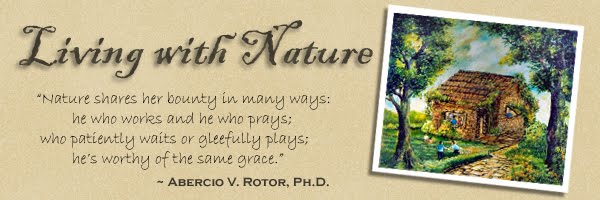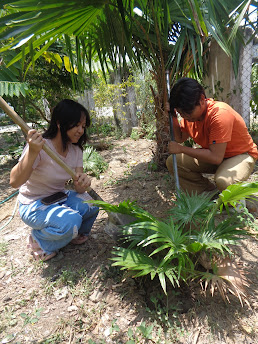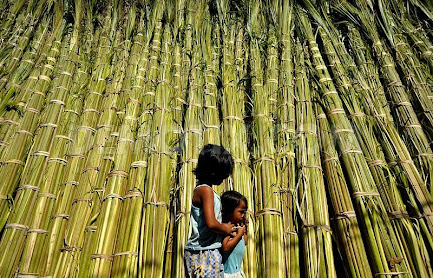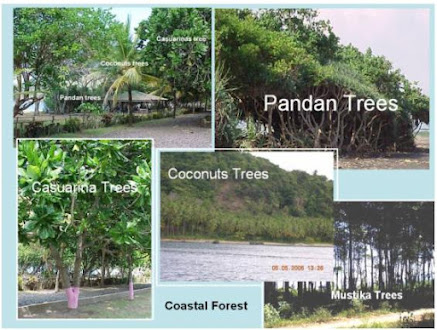Let Us Plant Trees This Palm Sunday
Dr Abe V Rotor
Please don't destroy Nature on Palm Sunday (Domingo de Ramos). Don't kill the palm trees and other threatened and endangered species (cycads, buri, anahaw, nipa, and the like). Help arrest climate change, soil erosion, deforestation, wildfire, onslaught of tsunami, and many other ecological disasters. Trees contribute to good health and happy living,
This is an appeal addressed to the Church, the DENR (Department of Environment and Natural Resources) and other agencies whose functions are related to environmental conservation. Lavish and unmindful celebration of Palm Sunday is detrimental to the coconut industry, and the endangerment, if not extinction of palms, among them buri, nipa and anahaw - and the living fossil Cycad or oliva.
Heritage Anahaw palm trees are part of the Center's Arboretum (Miniature Forest).
Anahaw belongs to Family Arecaceae, formerly Palmae. It is a large family, with approximately 2,600 species and 181 genera, primarily found in tropical and subtropical regions. Palms range from shrubs to large trees, characterized by unbranched stems and terminal clusters of large leaves called fronds.
Palm Sunday - Nemesis of Palm Trees
The world suffers from huge economic loss and ecological decline from lavish and unmindful celebration of Palm Sunday or Domingo de Ramos.
A pathetic scene around churches after Palm Sunday celebration
Let's join the movement Ecological Reconciliation espoused by the Holy Father (Laudato Si' Encyclical), and local church leaders led by Fr Benigno Beltran SVD. This is a yearly appeal from this website addressed to the leaders of the Church, the faithful, and mankind as one. Let's plant trees instead and take good care of them.
The world loses billions - actual and potential, economic and ecological - every Palm Sunday. Coconut-based economy is the worst hit - the source of many domestic and export products, and the foundation of people's livelihood. The coconut is the most important tree in maintaining the balance of tropical ecosystems.
Whatever happened to the sacredness of Palm Sunday!
Bundles of palm fronds (young leaves of coconut and other palm trees) attest to the massive destruction and decimation of palms in the Christian world.
Lavish and wasteful observance of Lent while Nature suffers
and people lose their livelihood.
Let's join hands to save the trees
- Don't use young (bud) leaves of coconut for palaspas. You will kill the tree.
- Conserve the Oliva or the Cycads. They are living fossils, older than the dinosaurs. They are now endangered.

- Don't strip the young leaves of buri and anahaw palms. They are now in the list of threatened species.
- Get only the mature leaves - never the young leaves or bud.
- Get only a small leaf or part of it. Don't be wasteful.
- There's no need for each member of a family to carry palaspas. One for a whole family is enough.
- Get substitute plants that are not ecologically endangered and economically threatened. (Examples: MacArthur's Palm, palmera, Areca or betel nut, bunga de Jolo, and non-palm plants from bamboo to ground orchid). Use mature or older leaves - never the young leaves and buds.
- Seek advice from your community and religious leaders, and environmentalists.
 • Retreat and reflection is therapy, helps the mind and body release tension and do away with the effects of stress.
• Retreat and reflection is therapy, helps the mind and body release tension and do away with the effects of stress.Buri palm (Corypha) is now classified as threatened species
• Abstinence conserves animal population especially during the lean months, conserving breeding stocks - like seeds (binhi) – in order to multiply in the next season.
• To some religions pork is banned. Pork is a carrier of known parasites such as tapeworm, hookworm, and ascaris.
• On Palm Sunday trees are stripped off of their buds, leaves and stems. This is detrimental to the environment especially in summer when plants face tight water regime. Millions of pesos worth of coconut trees, potential to provide nuts continuously for a period of up to 30 years, are simply sacrificed for a day's ritual. Endangered species such as the Cycad (Oliva), are pushed to the brink of extinction.
• Ancient religions regard certain places and trees sacred, thus enhancing their conservation. Such worship was replaced by later religions, thus losing their protection.
• The washing of feet is not only ritual, it is also sanitation, getting rid of germs and preventing their spread.
. Avoid dipping your fingers into the holy water bowl, and never wash your hands or face in it. Running holy water is best.
. Take communion on your palm, never with your tongue. Epidemic such as H1N1 (flu) can be spread this way.
Holding hands in prayer is discouraged also for health and sanitation, keeping ones privacy in reverence, notwithstanding. Kissing icons is likewise discouraged for the same reason. Wiping holy objects with handkerchief will only pick up germs.
. Paying last respect to the dead should be done with extreme care, especially if the cause of death is highly contagious like anthrax, Ebola and SARS. Remember the tragic death of some religious sisters who contacted Ebola from their dead colleague?
. Don't walk on your knees to the altar; kneeling in prayer is enough. Be kind to your knee tendon and kneecap; knee injury may incapacitate you permanently. "You re not growing younger," an elder advised me. Let's learn from athletes who retired early because of knee injury.
. Removing shoes before entering a house of worship is an expression of respect and reverence, as well as for purposes of maintaining sanitation in the place. Any footwear carries dirt and germs, and may be teems with bacteria and fungi from long and intimate wear. This practice may not be as strict in Catholic churches as in Muslim mosques and Buddhist temples. Removing shoes in other places like prayer rooms, wakes, even homes, are becoming a popular practice.
. Many religious ceremonies are without the use of incense. Incense smoke and scent usually produce a pleasant and calming effect to the faithful. It is also an effective fumigant against flying and crawling insects. Its repellant effect helped keep down the spread of bubonic plague during the Middle Ages. The causal organism which killed a third of the population in the known world is carried by flea (Xenopsylla cheopis) that resides in rats. Incense comes in various preparations and offerings, candle sticks among the most common. Burning candles have similar but lesser effects. To get rid of flies around food, plant one or two burning candles to keep them at bay. Try it.

Sprinkling holy water with lotus flower before entering the Buddha Shrine. (Grand Palace, Bangkok)

Candle offering is often wasteful and dangerous. It also makes the place untidy. A lighted candle in an enclosed room reduces oxygen level while filling it with CO2 and the deadly Carbon Monoxide. (Our Lady of Manaoag Shrine, Manaoag Pangasinan.)
Proof of destruction on the altar of faith could be as evident as after a typhoon and other force majeure on the economy and environment.
Coconut tops other coastal trees against the onslaught of tsunami and storm surge.
(Acknowledgement: Internet and FAO photos)
NOTE: This article served as a yearly lesson for 30 years on the defunct Paaralang Bayan sa Himpapawid with Ms Melly C Tenorio as host and the author as broadcast instructor. 738 DZRB AM, 8 to 9 evening class, Monday to Friday, linked with Philippine Broadcasting Service (PBS) network, and this Blog avrotor.blogspot.com
Earth Day 2016 (Reprint, Living with Nature)
Death of a living fossil - Oliva (Cycad) It is a loss of a beautiful landscape that transports us to the enigmatic Mesozoic world when man was not yet conceived to evolve through a long path to become what we are today.
Dr Abe V Rotor
Living with Nature - School on Blog (avrotor.blogspot.com)
The Cycad is a living fossil, older than the dinosaurs. It appears today as it was some 200 millions years ago. Among its secrets is its benevolence as host of a variety of organisms living in a state of dynamic balance which characterizes an ecosystem. Living with Nature - School on Blog (avrotor.blogspot.com)
Lesson on TATAKalikasan AdMU, Usapang Bayan (radio programs), and on former Paaralang Bayan sa Himpapawid (People's School-on-Air)
One day this beautiful palm-like tree died. It is a great loss to students in biology, for it has not been fully studied and understood. It is a loss to a beautiful landscape that transports the viewer to the Mesozoic era when man had yet to evolve into what we are today.
Young Markus (author's grandson) is introduced early in the study of living things with the help of his Nanny. The twin crown once lush in radial symmetry for half a century has dried up, so with all the plants clinging on its trunk.
Young Markus (author's grandson) is introduced early in the study of living things with the help of his Nanny. The twin crown once lush in radial symmetry for half a century has dried up, so with all the plants clinging on its trunk.
The palm-like tree succumbed to drought and pest, bringing down all its symbionts - orchid, fern, lichen, moss, blue-green alga, and a host of small organisms from insects to reptiles - to their inevitable demise. A tree is actually a miniature ecosystem. Thus the death of this cycad put an end to the ecosystem it built and maintained throughout its long life.
Oliba, Oliva, pitogo (Cycas revoluta) has been called the "living fossil" because of its origin traced to the ancient flora of early Mesozoic era, (200 million years ago). A native to Japan and southern China, it is now cultivated mainly for ornamental purposes.
Reproduction of cycads, typical of all Gymnosperms (pines and cypresses) showing cone with seeds. Right, new set of leaves after the seeds have been disseminated. There are cycads which are dioecious (distinct male and female individuals).
Sago flour is derived from the pith but requires an ethnic process to wash out the toxin. Same is true with the fleshy seeds which are consumed as food and medicine in southern Japan, the natives of Guam, New Guinea, Australia, and the western Pacific Islands. The ethnobotanical uses extend to the cure of high blood pressure, headaches, congestion, rheumatism and bone pain. Leaves are used in the treatment of cancer and hepatoma, while the terminal shoots are used as astringent and diuretic.
The main folkloric use of cycad today in the Christian world is for palaspas. Fresh whole leaves are harvested and “blessed” on Palm Sunday. Whole trees are often stripped of their crowns, weakening and predisposing them to extreme conditions of the environment, pest and diseases. Although cycads are deciduous (they lose their crowns periodically), this practice retards growth and reproduction, and may cause the plants to die. A popular traditional practice is suob. The leaves are dried and powdered, and added to incense (insenso) for the ritual. Its aroma therapeutic effect is well known to many ethnic communities.
The Cycad offers vital research topics that challenge the scientific mind, particularly among our youth. Perhaps we may learn from the prototype world of this living fossil plant answers to our ailing health and deteriorating environment. Indeed the Cycad is Nature's primordial laboratory of natural history
A. Medicine and Pharmacology
- Presence of aromatase inhibitors
- Lectin and Peptide Analysis
- Antimicrobial and Antioxidant
- Bactericidal/Antibacterial properties
- Chitinase isolation and analysis
B. Biology and Ecology
- CO2 and pollution tolerance
- Nitrogen-fixation with cyanobacterium
- Lichen and floral composition
- Species diversity and phylogeny
- Evolution and longevity
Cycads are gymnosperms (naked seeded), meaning their unfertilized seeds are open to the air to be directly fertilized by pollination, as contrasted with angiosperms, which have enclosed seeds with more complex fertilization arrangements. Cycads have very specialized pollinators, usually a specific species of beetle. They have been reported to fix nitrogen in association with a cyanobacterium living in the roots. These blue-green algae produce a neurotoxin called BMAA that is found in the seeds of cycads. This neurotoxin may enter a human food chain as the cycad seeds may be eaten directly as a source of flour by humans or by wild or feral animals such as bats, and humans may eat these animals. It is hypothesized that this is a source of some neurological diseases in humans. (Internet)




































No comments:
Post a Comment